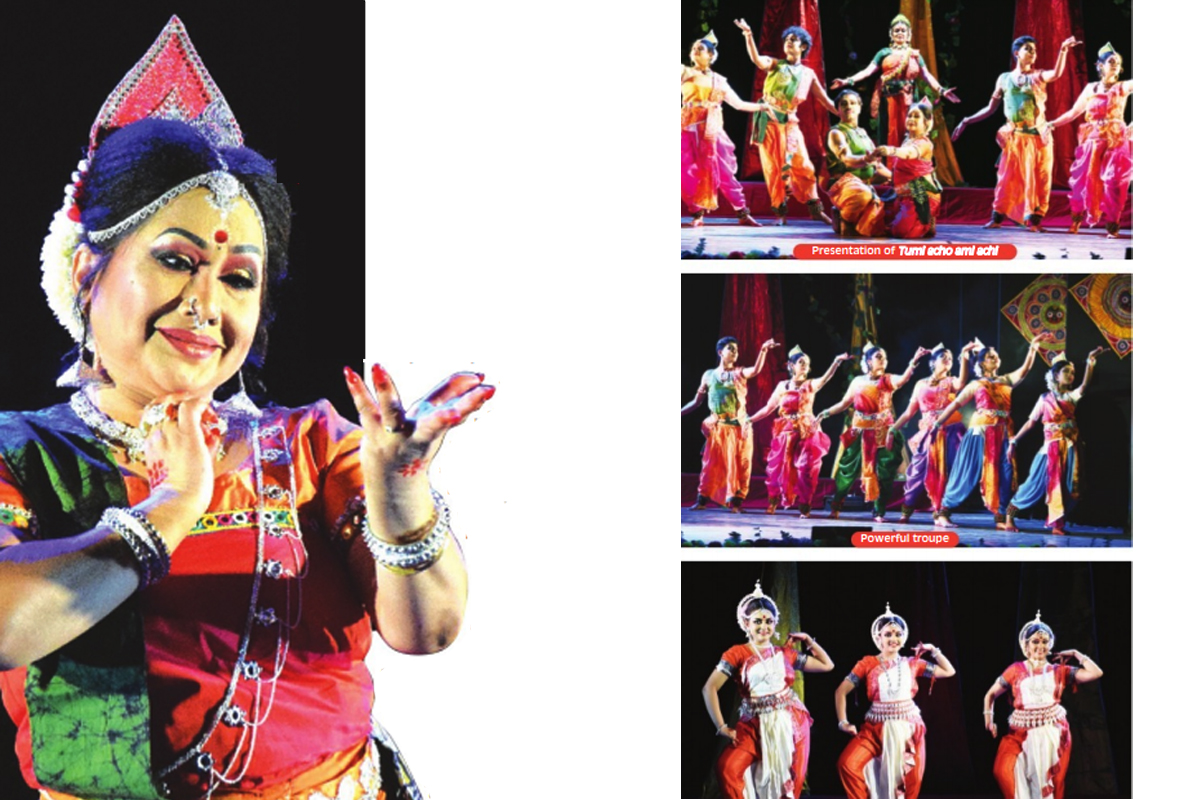Balmiki Pratibha takes the final bow with its 100th act
On Sunday, 17 November, Rabindra Sadan witnessed the 100th and final staging of Balmiki Pratibha, Rabindranath Tagore’s timeless tale of redemption.
City dwellers were enthralled by the creative dance drama that was aesthetically executed at a soiree recently.

Photo: SNS
An evening of Odissi dance, with the added fare of a drama in dance Tumi acho ami achi in Odissi techniques punched with aesthetic abhinaya was a recent presentation of Nrityangana at Mahajati Sadan.
Maya Bhattacharya, the artistic director of Nrityangana has honed her Odissi dance skill from Kelucharan Mohapatra from an early age. Presently she is under the tutelage of the doyen’s son Ratikant Mohapatra. It is almost a given fact that no dancer wants to start her programme, without appeasing the God who, if displeased, has the reputation of causing obstruction. Therefore half a dozen repertory members of the institute performed songs and danced in praise of Ganesh at Mangalacharan— a choreographic work of Ratikant Mohapatra. Bhattacharya selected compositions from Kelucharan Mohapatra and Muralidhar Majhi and choreographed them in group compositions. Prana sangini re rendered solo was sensuous and graceful, in which the bhakti bhavawas executed well, with just the right combination of rasa and laya. Pran sangini re is the story of Radha who was tricked by Krishna. Before the presentation of the dance drama, traditional pieces like Botu, Chari, Pallavi, Bhromori and Dashavatar leading to moksha were performed by Bhattacharya and her disciples.
Advertisement
The dance drama Tumi acho ami achi was brilliantly conceptualised with a message. However, the message fell into line in the same old way of thinking, where the woman or nari has been destined to carry on the role of cleansing all evils that beset us, by assigning to her an elevated and larger than life, Devi like position.
Advertisement
The works of Rabindranath Tagore are indeed precious that hold the hope of delving deep and finding lyrics which express all the human feelings. Basically the concept of the dance drama deals with the relation, between prakriti and nari— nature and woman— which is inseparable. The theme refers to the depletion of our environment and the need for its conservation. Every thought process included in the theme was expressed with proper selection from the inimitable wealth of Rabindrasangeet. Nature was welcomed with the song Esho shyamolo sundoro, glorifying its beauty. Hey Nirupama describing the peerless beauty of nariis basically a love poem by the poet of nature. He is unable to take his eyes off from her dusky eyes and asks to be forgiven, should he become frivolous with the first shower of rain. Appropriateness of the choice of the song to be rendered solo by the character of nari cannot be debated.
The storyline clarifies that nature and man are inseparable in striking a balance for each other’s existence. Human beings cannot survive without nature. Man owes his very existence to nature, but greed spoils this balance. It is his greed that woe besets the world, which can only be cured with bestowing immeasurable love, that only a woman is capable of giving. To show the restlessness of the times, the song Asanti aaj hanlo was the most fitting. The dance steps, movements, hand gestures and vigorous group movements were representatives of the present chaotic times, when nothing seems to be going right. Songs and recitations told the poignant tale. The lyric Bhalobasi bhalobashi gave the message of love that is the only answer. The inclusion of a Baul singer singing Tui phele esechis kare mon mon re amar to represent the conscience of man was done creatively. It also provided the colour that was needed to enliven the story.
A child who is born to a corrupt world, devoid of nature can only spell doom. The song Utal hawa witnessed a welcome change, where there is unity, solidarity and peace amongst each other, nurturing a fondness with nature. Almost all the songs chosen from the Gitabitan fell to soothing ears, leaving the audience ponder for more. The songs that touched a chord in the listener’s memory were: Aye tabe sahachari, Mor bhabonare ki haway matalo and Bhalobasi bhalobasi.
It was a creative piece of work on recorded music. The vocalists Maya Bhattacharya herself assisted by Mita Nandan and Sabysachi Chandan sang well. Debasish Basu was a good master of ceremonies.
Advertisement